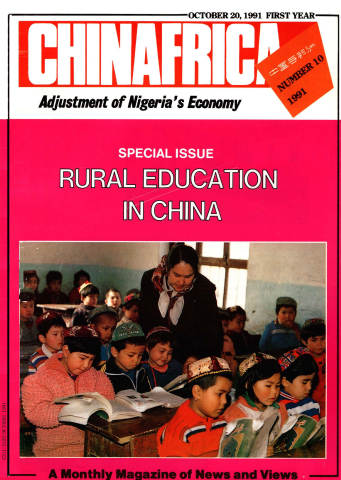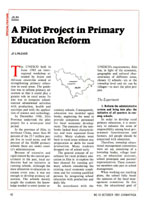The UNESCO held in June 1985 an interregional workshop attended by Asian and African countries aimed at strengthening primary education in rural areas. The guideline was to reform primary education so that it could play a greater role in rural areas. Its aim was to integrate school-centred educational activities with production, health and nutrition and with the application of science and technology.
In December 1986, Jilin Province undertook the pilot project for a seven-year trial period.
In the province of Jilin, in northeast China, more than 80 percent of the 23.7 million people live in rural areas, and 80 percent of the 10,000 primary schools there are under county's administration.
Because of excessive and rigid control by the central government in the past, local authorities had no initiative in running schools. Although the state allocation to education increases every year, it was not enough to develop primary education. The schools merely taught the students the knowledge needed to enter junior secondary schools. Consequently, education was modeled upon books, neglecting the need to provide competent personnel for local economic development. The contents of the textbooks lacked local characteristics and were separated from reality. Many students went back to rural areas without any preparation or skills for rural production. Many students dropped out of school early.
The general concept of excellence for rural primary education in Jilin is: to explore the best channel for running primary schools considering the existing rural economic conditions and for training qualified persons by integrating school education with production and daily life.
In accordance with the UNESCO’s requirements, Jilin has, in light of the economic, geographic and cultural characteristics of different areas, chosen 12 schools—six at the township level and six run by villages—to start the pilot project.
The Experiment
1.Reform the administrative system and bring into play the initiative of all quarters in running schools.
In order to develop rural primary education, it is necessary to enhance the sense of responsibility among local government functionaries and farmers. All people should be concerned with education.
Therefore, township educational management committees were set up, consisting of a township leader, village leaders, an education assistant, school principals and parents’ representatives. These committee members take part in school management.
When working out teaching plans, the school fully heeds the opinions of the local management committee. In this way, the educational goal of primary education coincides with the interests and wishes of local farmers.
The management committees mobilized farmers to help schools set up productive labour bases for teaching practice. They also co-ordinated the relations between schools and local farming technique stations, agricultural research institutes and hospitals. These organizations take the responsibility of providing schools with information and technical guidance and send professional workers to schools as part-time teachers. Besides, the management committees have also set up the “joint school-village-household educational group.” Households engaged in production along specialized lines provide land, facilities and techniques to the schools and help pupils learn advanced techniques in production and management.
Parental guidance committees have been set up. As a result, schools and families join up through the committee, and together take the responsibility of the pupils’ education. The schools invite parents who have special skills in certain fields as part-time instructors for extracurricular activities. Over 300 family scientific experiment corners have been set up. The schools also help parents learn educational theory and methods and knowledge in nutrition and health.
2.Revamp teaching contents to promote the combination of school education with local production and life.
In accordance with the UNESCO’s recommendations, universal elementary teaching content was combined with local teaching material.
A.Supplementary Chinese and maths teaching material.
Chinese and maths are the two basic subjects in primary schools. In order to apply them to rural production and to make sure pupils in both experimental schools and regular schools receive equal basic education, the educational departments of the province have compiled two copies of supplementary teaching material on the Chinese language, based on the commonly used Chinese vocabulary and practical writing, and three copies of supplementary teaching material on practical maths, reckoning by abacus, and quick mental calculation. This material was used by experimental schools for classroom use and extracurricular activities as well.
B. Local teaching material.
This material is intended for pupils to develop skills closely related to the local production and life. The teaching material compiled so far is:
● “Hometown,” dealing with local geography, economy, history, conditions, customs, and anecdotes, to instill in pupils a love for their hometown.
● “Manual Labour” and “Hygiene.” Manual labour courses aim at teaching junior high school students how to take care of themselves. Knowledge of simple productive and technical skills are diffused among senior high school pupils. Hygienic knowledge focuses on hygienic habits, disease prevention and cure, and nutrition hygiene.
● “Productive Techniques,” on local practical techniques, used for the development of the pupils, production skills.
The instructional programme has been readjusted to make good use of supplementary and local teaching material. Flexible class hours were used to teach supplementary material and manual labour courses, and extracurricular activities were added to the teaching programme.
3.Widen the education approach to prepare students for rural economic development.
According to the UNESCO's requirement that primary education should be combined with other forms of education, a new educational approach was established which combined classroom teaching, field practice and extracurricular activities.
A. Improve classroom teaching and stress the importance of fundamental education.
In the classroom, the teaching contents, methods and activities are optimized. Teaching activities in and out of classes are combined; teachers from outside are invited to integrate theory with practice. The pupils learn practical techniques and lay a foundation for their future participation in agricultural production.
B. Bring the school production bases and manual labour courses into play.
● Pupils of every grade learn elementary agricultural knowledge and productive techniques at school labour bases.
● At present every school has scientific research equipment and every class has a experimental base. In the bases, experiments are made on new agricultural technology and field-managements. Pupils show profound interest in these experiments, prefering them to regular classes.
● The pupils come from everywhere and can spread information and advanced scientific experimental results to each family. Agricultural technique popularization stations and seed companies have provided these schools with improved crop strains, advanced insecticides, herbicides and chemical fertilizers. In 1987, the Taiping School conducted comparative experiments with more than ten improved strains of corn, and in this way found the strain which was best suited to the local conditions. The crop has been popularized over the last couple of years. Last year, Taipin Township reaped a per-hectare yield of more than 10,000 kg, the highest in the county. After the primary school in Fengman Township introduced a high-quality forage grass from the United States, local farmers quickly followed suit. The township’s 4,000-odd milk cows, which used to feed on grass and corn stalks, all grow well on the imported forage grass. Thus schools have played an important part in the development of the local economy.
C. Bring into play the role of joint educational groups and let students master advanced production and management know-how.
Joint school-village-household educational groups which have been set up in many schools have invited specialized farmers as part-time teachers. In return pupils work for them without pay. In this way they can learn advanced production technology and management knowledge. Many pupils have learned how to feed milk cows, raise chickens, and breed fish and rear animals.
D. Carry out extracurricular activities to develop the students' personalities.
Extracurricular activities are considered as an extension and complement to classroom teaching and an effective way of connecting education with production. The 12 experimental schools have organized some 172 after-school activity groups. Students can choose the kind of activities suited to their personal interests.
These activities range from abacus use to animal raising and cultivation, as well as weaving and repairing.
E. Organize activities for students to learn about society.
Social activities are an important means to help students understand and judge the society with a positive attitude. They are organized to investigate the history of the villages, visit farmers who have “made it” through hard work, look into the situation of drop-out students and talk to farmers engaged in production along specialized lines. To develop the pupils’ moral values, voluntary manual labour and social work are also organized.
4.Strengthen the training of teachers to meet the requirements of reform.
Teachers are required to fulfill basic teaching tasks while learning another professional course to be able to organize and direct extracurricular activities.
To make up for teacher shortage, part-time teachers are invited from departments associated with the schools and among experienced farmers.
5.Reform the educational evaluation standard to promote the pupils' all-round development.
To make the educational evaluation standard compatible with the objectives of the pilot project, the educational evaluation method has been improved by combining overall qualification standards with various means to evaluate the pupils' ideology, academic achievement, health, character, behaviour, intelligence, work habits and potential, etc. Evaluation is both qualitative and quantitative; oral tests and written work is combined with practical tests and academic evaluation with social evaluation. The pupils’ achievement in scientific farming is always evaluated by technological departments in agriculture, their skills in labour by their part-time teachers and experienced farmers and their behaviour by their parents.
Initial Achievements and Experiences
After four years, the experiment has made remarkable achievements, as listed at the end of this text.
1.Education and facilities were improved with the increase of educational funds. (See Table 1-2)
2.Manual labour bases were built. (See Table 3)
3.Supplementary textbooks and local teaching material was compiled.
4.Competent teachers were trained. (See Table 4)
5.The pupils, qualifications were improved. (See Table 5-6)


Tab.l. Comparison Between the Annual Funds of the 12 Experimental Schools (Yuan)

Tab.2. Camparison Between the 12 Schools,Educational Facilities
Tab.3. Scale of the Production Bases of the 12 Experimental School

Tab.4. Comparison Between Teachers,Schooling Record and Their Professional Ability

Tab.5. Comparison Between Graduating Grades of Experimental Schools (ES) and Regular Schools (RS)

Tab.6. Comparison Between Pupils,Improved Qualification of the ES and RS


 Copy Reference
Copy Reference 